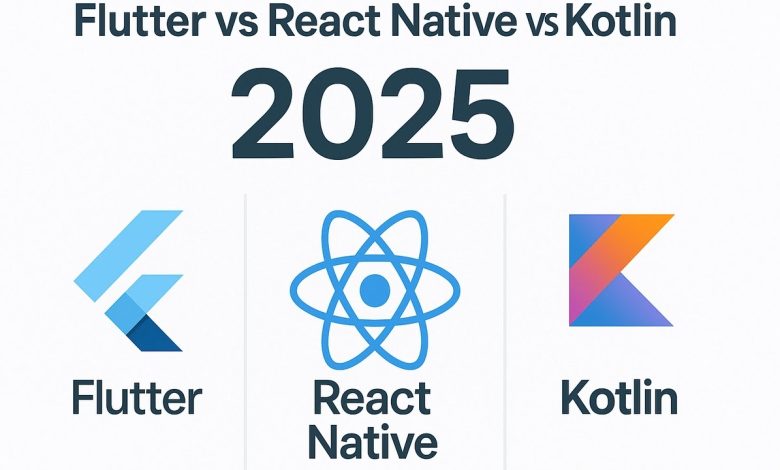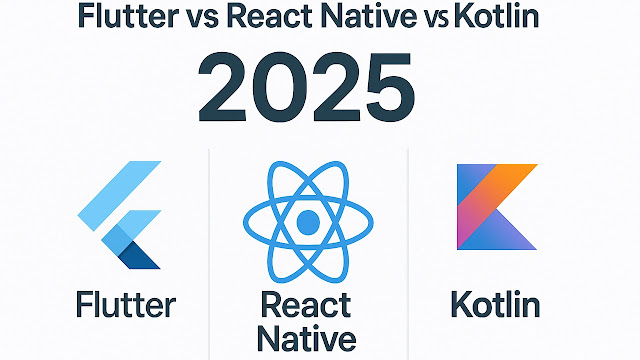Building Cross-Platform Apps: Flutter vs React Native vs Kotlin Multiplatform

In today’s fast-paced mobile ecosystem, users expect apps to be fast, beautiful, and consistent — no matter which device they use. For developers, this means building apps that run seamlessly on both iOS and Android (and even beyond).
But maintaining two separate native codebases has always been a headache. That’s where cross-platform frameworks come in.
By 2025, three major technologies dominate the cross-platform landscape: Flutter, React Native, and Kotlin Multiplatform (KMP). Each offers a unique approach to building apps efficiently, blending native performance with shared logic.
In this article, we’ll dive deep into how these frameworks work, their strengths and weaknesses, and which one might be the best fit for your next project.
1. The Evolution of Cross-Platform Development
For years, developers faced a tough choice:
- Build native apps (Swift for iOS, Kotlin/Java for Android) for maximum performance.
- Or use hybrid frameworks (like Ionic or Cordova) to save time — but sacrifice speed and native feel.
Then came a new generation of frameworks — Flutter, React Native, and Kotlin Multiplatform — that changed the game.
They allow developers to share logic and UI between platforms without losing native-level performance.
2. Flutter: The UI Powerhouse by Google
Flutter, developed by Google, has quickly become a favorite among developers for its speed, flexibility, and consistent design.
How It Works
Flutter uses the Dart programming language and compiles directly to native ARM code.
Instead of using platform-specific UI components, it renders its own via a high-performance rendering engine called Skia.
This means your UI looks and behaves identically on iOS, Android, Web, and even Desktop.
Why Developers Love Flutter
- Single UI codebase: Build once, deploy everywhere — mobile, web, desktop, and embedded.
- Hot Reload: Instant updates for rapid iteration.
- Material You & Cupertino Widgets: Native-like designs for both platforms.
- Performance: Near-native FPS (60–120) thanks to direct rendering.
- Ecosystem: Flutter 4.0 now supports WebAssembly, AI-driven animations, and modular plug-ins for AR/VR.
Use Cases
- Startups building MVPs quickly.
- Enterprises wanting consistent UI across multiple devices.
- Apps with heavy custom design needs (e.g., eCommerce, FinTech dashboards).
Limitations
- Larger app size compared to pure native.
- Slightly higher memory consumption.
- Less integration depth for extremely OS-specific APIs (though improving fast).
Verdict: Flutter remains the best all-in-one choice for developers who prioritize design consistency and rapid development.
3. React Native: The JavaScript Veteran
React Native, created by Meta (Facebook), revolutionized cross-platform development when it launched in 2015.
By 2025, it’s still a major player — but with major improvements under the hood.
How It Works
React Native uses JavaScript (or TypeScript) and the React paradigm — “UI as a function of state.”
It renders components via a JavaScript bridge that communicates with native APIs.
However, recent versions have reduced reliance on the bridge through Fabric architecture and TurboModules, boosting speed dramatically.
Why Developers Still Choose React Native
- Familiar syntax: React devs can instantly build mobile apps.
- Huge ecosystem: Countless libraries, tools, and community packages.
- Expo SDK: Simplifies development and deployment with cloud builds.
- New architecture (Fabric): More efficient rendering and concurrent processing.
- AI integration: Seamless integration with AI SDKs like TensorFlow.js and OpenAI APIs.
Use Cases
- Companies with existing React web teams.
- Social, eCommerce, and media apps with dynamic UIs.
- Projects that require frequent updates and over-the-air patches.
Limitations
- UI inconsistencies can appear across platforms.
- Performance still trails Flutter in graphics-heavy apps.
- Native modules sometimes require manual bridging.
Verdict: React Native is ideal for JavaScript-heavy teams or web developers transitioning to mobile — flexible, powerful, and proven.
4. Kotlin Multiplatform (KMP): The Enterprise-Grade Powerhouse
Kotlin Multiplatform (KMP), built by JetBrains and supported by Google, takes a fundamentally different approach to cross-platform development.
Instead of sharing the UI, KMP focuses on sharing business logic, networking, and data layers — while keeping each platform’s native UI intact.
How It Works
Developers write shared code in Kotlin (e.g., for APIs, models, and databases) and use native tools for the UI:
- Jetpack Compose for Android
- SwiftUI for iOS
The shared Kotlin code is compiled to native binaries via Kotlin/Native, allowing full integration with platform APIs.
Why Enterprises Love It
- Native UI flexibility: The best of both worlds — shared logic, native look.
- High performance: No bridges or JS layers.
- Type safety: Kotlin’s null safety and coroutines ensure robust concurrency handling.
- Scalable architecture: Perfect for large teams dividing UI and logic.
- Tooling: Excellent IntelliJ and Android Studio support.
Use Cases
- Enterprise apps requiring stability and scalability.
- Apps that need deep platform integration (camera, sensors, system APIs).
- Teams maintaining existing native codebases but wanting shared business logic.
Limitations
- Slower initial setup.
- Smaller community and fewer ready-made libraries compared to Flutter/React Native.
- Requires expertise in both Kotlin and native UI frameworks.
Verdict: Kotlin Multiplatform is best for long-term, performance-critical enterprise projects where maintaining platform-native UIs is essential.
5. Performance Comparison (2025)
| Feature / Framework | Flutter 4.0 | React Native (Fabric) | Kotlin Multiplatform |
|---|---|---|---|
| Language | Dart | JavaScript / TypeScript | Kotlin |
| UI Rendering | Custom (Skia Engine) | Native Components | Native UI |
| Performance | ★★★★★ (Near-native) | ★★★★☆ (Improved with Fabric) | ★★★★★ (Native) |
| Developer Experience | ★★★★★ | ★★★★☆ | ★★★★☆ |
| Code Reuse | ~95% | ~85% | ~60–70% |
| Best For | Startups, multi-device apps | Web-to-mobile teams | Enterprise-grade apps |
| Community Size | Massive | Massive | Growing rapidly |
6. Beyond Mobile: Expanding Horizons
In 2025, these frameworks go far beyond smartphones.
- Flutter supports Web, Desktop, and Embedded (IoT) apps.
- React Native integrates with Windows, macOS, and Web via React Native for Web.
- Kotlin Multiplatform powers backend services, desktop apps (Compose for Desktop), and even watchOS.
Cross-platform development is now truly multi-platform, blurring the line between mobile, web, and desktop.
7. Integration with Modern Architectures
Modern apps are rarely standalone — they connect to APIs, cloud services, and edge networks.
Each framework now supports modular, cloud-native architectures:
- Flutter integrates easily with Firebase, Supabase, and AWS Amplify.
- React Native thrives in CI/CD pipelines using Fastlane, Expo, and EAS Build.
- Kotlin Multiplatform connects seamlessly with Ktor, SQLDelight, and GraphQL APIs.
Moreover, AI is starting to assist developers in these environments — automating testing, performance profiling, and even code reviews.
8. Developer Productivity and Tooling
Flutter
- Excellent documentation.
- DevTools for performance monitoring.
- Strong integration with VS Code and Android Studio.
React Native
- Supported by tools like Flipper, Redux DevTools, and Expo CLI.
- Live reloading and robust debugging ecosystem.
Kotlin Multiplatform
- Advanced refactoring and type inference in IntelliJ IDEA.
- Seamless Gradle integration and multiplatform testing support.
All three frameworks are rapidly integrating AI copilots to improve developer efficiency in 2025 — from real-time code suggestions to automated layout fixes.
9. Choosing the Right Framework
Here’s how to decide which framework fits your project best:
✅ Choose Flutter if:
- You want full control over design and cross-platform consistency.
- You’re targeting mobile, web, and desktop simultaneously.
- You prefer Google’s ecosystem and rapid development cycles.
✅ Choose React Native if:
- You already have React or web development expertise.
- You need fast delivery and a huge library ecosystem.
- Your app relies heavily on dynamic updates and content.
✅ Choose Kotlin Multiplatform if:
- You’re building enterprise-grade apps with long lifespans.
- You want shared logic but native UI flexibility.
- Your team includes experienced Kotlin or Android developers.
10. The Future of Cross-Platform Development
As 2025 unfolds, we’re witnessing convergence rather than competition.
- Flutter is evolving into a universal UI toolkit.
- React Native is modernizing its runtime with Fabric and edge compatibility.
- Kotlin Multiplatform is becoming the enterprise standard for hybrid-native development.
The next wave will likely include AI-assisted UI generation, edge-native deployment, and augmented reality (AR) integration directly within these frameworks.
In short: the future of app development isn’t just about writing once and running everywhere — it’s about adapting intelligently everywhere.
Conclusion
Cross-platform development in 2025 is mature, powerful, and production-ready.
Flutter leads in UI innovation, React Native excels in flexibility and ecosystem, and Kotlin Multiplatform defines the enterprise standard for scalability.
Whichever framework you choose, the goal remains the same:
Build fast, perform natively, and deliver experiences that feel seamless to every user — on every device.

